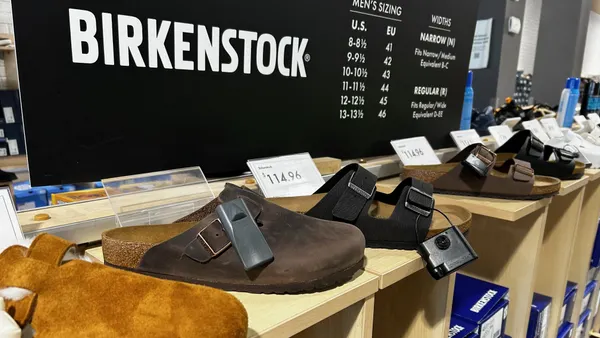Dive Brief:
- Target posted a blowout second quarter that included its best-ever comparable sales growth, of 24.3%, according to a press release.
- Included in that figure is store comp growth of 10.9% and digital comp growth of 195%. Comps for Target's same-day services (Pick Up, Drive Up and Shipt) were up a heady 273%. All of this growth led to "unusually strong" market share gains of around $5 billion in the first half of the year, according to the company.
- After a surprising profit decline in Q1, Target's Q2 operating income rose 73.8% to $2.3 billion. Earnings per share also set a record and were more than double the FactSet consensus, according to MarketWatch, and that's after the company made large investments in its team and safety measures for consumers.
Dive Insight:
Amid a triumphant string of numbers and successes during Q2, Target CEO Brian Cornell once again alluded to the uncertainty and volatility that surrounds the retail market shaped by COVID-19. As much as Q1, with its disappointing bottom-line results, failed to predict what Q2 would look like, he cautioned in an analyst call Wednesday that Q2 shouldn't be used to predict what the rest of the year will look like for the company.
That said, Q2 was really, really good — "better than anyone could have expected," as Wells Fargo analysts described it. MKM Partners analysts called it "an incredible quarter by all measures," and Moody's retail analyst Charlie O'Shea said in emailed comments that the performance "obliterated the bullseye, with every line item vastly exceeding our expectations."
Feeding the performance was a range of good news for Target, including an explosion in its same-day services, which the company has been investing in for years, now with vindication as they pay off in a turbulent time. But the retailer also saw store performance that was among the best in the company's history, according to Cornell.
Moreover, Target made market share gains across the board in its core categories, including in apparel, where the retailer has succeeded (Q1 notwithstanding) where others are struggling. Target also saw 70% growth in electronics and 30% growth in home, among gains elsewhere. Apparel and home are two areas where Target has invested heavily in a private label reset now yielding dividends. The company's Good & Gather food brand, launched just a year ago, has already reached $1 billion in sales, Cornell said.
Target's growth broadly peaked in May, Cornell said, and by August comps were down to double digit increases, which, as he pointed out to analysts, is still quite good for the retailer. He noted that the team planned to leave its back-to-school assortment on shelves for longer than usual, with parents facing uncertainty with school operations amid COVID-19 disruptions, which hints at a slow start to the season. The company also anticipates less trick-or-treating this Halloween and is adjusting its candy merchandising accordingly, Cornell said.
But Target, if Q2 is an indicator, is well-equipped for changes in shopping habits that started before COVID-19 but have been accelerated by the pandemic. Key to sales growth and healthy profits for the company are its stores, both as a sales channel and logistics node. Cornell said that the company's "most valuable and profitable" customer shops in all channels. Target COO John Mulligan said that a multi-channel guest spends four times as much with Target as a store-only guest.
Mulligan also addressed "nagging questions we continue to hear" about Target's ability to profitably scale its store fulfillment operations. During the quarter, stores fulfilled some 90% of sales in some fashion. Mulligan noted to analysts that the retailer's year-to-date digital sales have already eclipsed 2019's, and done so well before the holiday season and amid wild, unanticipated swings in shopping behavior this year.
Target sustaining its performance in Q2 is "highly unlikely," in the view of Neil Saunders, GlobalData Retail managing director. For one, shoppers have leaned on Target while curtailing trips to other retailers, including malls, as Saunders noted. "However, the pandemic has exposed it to more shoppers and shown the strengths of its business model," he said. "As such, we believe it will remain on an elevated trajectory."















